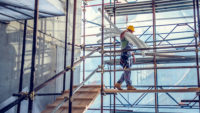High-rise crane operations can be fatally dangerous if construction teams aren’t careful. While that may seem obvious, instances of crews overlooking critical crane safety steps are all too common.
The Bureau of Labor Statistics reports roughly 44 crane-related deaths per year. This figure doesn’t include near-miss accidents. While such data is widely available, incidents still happen, suggesting statistics alone may not be enough to encourage safer behavior.
Recent Crane Collapses
The importance of thorough safety procedures is easier to grasp when viewed through the lens of recent accidents. Several crane collapses have occurred over the past months that illustrate the dire need for change.
Fort Lauderdale, Florida, April 2024
In April 2024, a 27-year-old rigger died after falling 30 stories from a tower crane in Fort Lauderdale, Florida. As a result, OSHA imposed a fine of $61,299 — the maximum penalty the agency can legally recommend — against the two contractors it found at fault.
The fatal fall happened when a support cable on the crane failed, causing the platform two workers were standing on to slip. While one employee was wearing proper safety harnessing and survived, the other was not.
OSHA found five serious violations contributing to the tragedy. One contractor failed to identify and replace faulty bolts in the crane’s climbing frame, ensure the use of fall protection and to pre-inspect the crane. The crane rental company failed to recognize the deficient parts and allowed employees to start working without an additional inspection.
Brooklyn, New York, August 2024
Another crane collapse occurred four months later in Brooklyn, New York. Part of a crane boom crashed into a nearby apartment building, damaging part of the roof.
Unlike the Fort Lauderdale case, no one was killed or injured in this accident. However, it could have been far worse.
The cause of the collapse is still under investigation, so OSHA and other authorities have yet to issue any penalties. Still, it highlights the need for greater care on the worksite. Occupants were in the apartment building at the time, and broken crane booms don’t typically occur without there being signs of wear, which a thorough inspection should have caught.
St. Petersburg, Florida, October 2024
Some high-rise crane collapses occur because of extreme outside forces. Such is the case of a St. Petersburg crane that fell nearly 550 feet from high winds from Hurricane Milton. While the machinery fell into an empty building, the resulting damage was immense and could have been worse had people in the area not evacuated for the hurricane.
The company behind the construction operation likely won’t face penalties, as Florida law does not mandate wind protection for cranes. However, the city reportedly advised the firm to take the equipment down before the storm. When they did not, officials instead warned nearby residents and businesses.
While a hurricane is not something most construction sites encounter, the St. Petersburg incident highlights the need for broader protections. Inclement weather can quickly turn a safe operation into a highly hazardous one. Greater care and forethought to account for such changes in risk could prevent injuries and material damage.
What to Learn from Recent Crane Incidents
These crane collapses show how failure to abide by safety standards affects human lives, even if a company escapes fines. Insufficient protections cause nearly 880 fall-related deaths each year, and as these cases show, even non-fatal accidents can lead to significant damage.
Failing to inspect equipment before using it can lead to a host of issues. That applies to both companies renting out cranes and teams using them on the job.
Recent accidents showcase how crane safety may need adaptation across different environments. The Brooklyn site had the added hazard of nearby residential buildings. The St. Petersburg collapse had to deal with special environmental circumstances. Safety leaders should take note of these differences and consider how their sites may pose unique risks.
Best Practices for Safe Crane Operations
Operators can avoid such incidents with attention to a few best practices. Here are four key steps to prevent collapses like those in Fort Lauderdale, Brooklyn and St. Petersburg.
1. Use the Right Equipment for the Job
The first measure is to match cranes and their complementary systems to the job at hand. A crane rated to withstand normal winds would not be safe in the St. Petersburg accident. Likewise, the Fort Lauderdale tragedy required additional attention to fall protection systems.
Carry deck cranes are good for mobility but unsafe on rough surfaces, so jobs on uneven ground should opt for a crawler crane instead. Jobsites in windy areas should implement additional rigging to prevent collapses.
2. Verify All Rigging and Fall Protection Before Use
Regardless of what equipment a firm uses, it must inspect it thoroughly before anyone gets on it. This applies to both the crane itself and to fall protection measures and any attached platforms.
Any signs of wear require further review before work can begin. Teams must either test the affected system to ensure it’s safe or repair or replace it. Contractors should also have experienced, certified employees perform these inspections to minimize errors.
3. Train Employees Thoroughly
Similarly, all employees working on or near a crane need extensive training. OSHA requires a qualified person to perform inspections, suggesting they should have formal education or firsthand experience in equipment safety and safe working protocols. However, businesses should go beyond this requirement.
All workers on the site should understand how cranes could impose hazards and know how to communicate any suspicious signs they notice. Requiring employees to re-test and certify their knowledge at least once a year will help prevent complacency from overruling safety.
4. Take Advantage of Technology
Finally, teams can take their crane safety further by capitalizing on technology. A recent study identified 13 technologies to address common hazards around cranes and their operation. These include the following:
- Drones
- Cameras
- Radar
- Fatigue-monitoring wearables
- Proximity sensors
- Wind speed sensors
Using systems like this will incur higher upfront costs. However, the added visibility and improved response times will more than make up for that investment by preventing costly, potentially deadly accidents.
Construction Crews Cannot Overlook Crane Safety
The need for crane safety should be evident, but as recent cases show, contractors still overlook some vital steps. Managers should respond to these stories by reflecting on their own operations for similar gaps. Learning from mistakes in the past can ensure a safer future.










